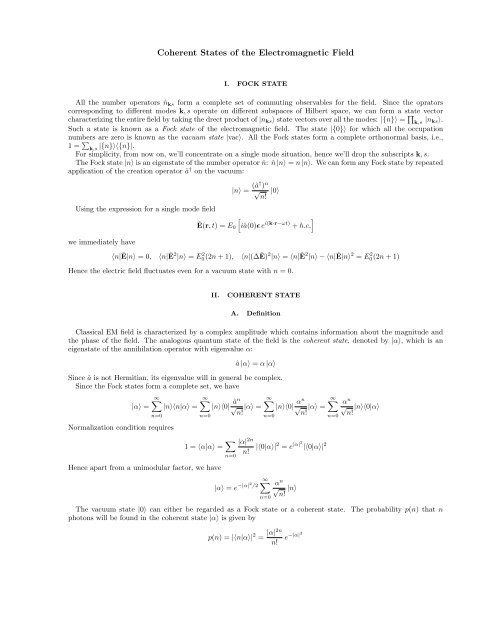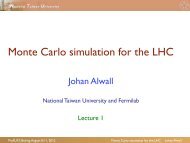Coherent States of the Electromagnetic Field
Coherent States of the Electromagnetic Field
Coherent States of the Electromagnetic Field
You also want an ePaper? Increase the reach of your titles
YUMPU automatically turns print PDFs into web optimized ePapers that Google loves.
<strong>Coherent</strong> <strong>States</strong> <strong>of</strong> <strong>the</strong> <strong>Electromagnetic</strong> <strong>Field</strong><br />
I. FOCK STATE<br />
All <strong>the</strong> number operators ˆnks form a complete set <strong>of</strong> commuting observables for <strong>the</strong> field. Since <strong>the</strong> oprators<br />
corresponding to different modes k,s operate on different subspaces <strong>of</strong> Hilbert space, we can form a state vector<br />
characterizing <strong>the</strong> entire field by taking <strong>the</strong> drect product <strong>of</strong> |nks〉 state vectors over all <strong>the</strong> modes: |{n}〉 = <br />
k,s |nks〉.<br />
Such a state is known as a Fock state <strong>of</strong> <strong>the</strong> electromagnetic field. The state |{0}〉 for which all <strong>the</strong> occupation<br />
numbers are zero is known as <strong>the</strong> vacuum state |vac〉. All <strong>the</strong> Fock states form a complete orthonormal basis, i.e.,<br />
1= <br />
k,s |{n}〉〈{n}|.<br />
For simplicity, from now on, we’ll concentrate on a single mode situation, hence we’ll drop <strong>the</strong> subscripts k,s.<br />
The Fock state |n〉 is an eigenstate <strong>of</strong> <strong>the</strong> number operator ˆn: ˆn |n〉 = n |n〉. We can form any Fock state by repeated<br />
application <strong>of</strong> <strong>the</strong> creation operator â † on <strong>the</strong> vacuum:<br />
Using <strong>the</strong> expression for a single mode field<br />
we immediately have<br />
Ê(r,t)=E0<br />
|n〉 = (↠) n<br />
√ n!<br />
|0〉<br />
<br />
iâ(0)ɛ e i(k·r−ωt) <br />
+ h.c.<br />
〈n| Ê|n〉 =0, 〈n|Ê2 |n〉 = E 2 0(2n + 1), 〈n|(∆ Ê)2 |n〉 = 〈n| Ê2 |n〉−〈n| Ê|n〉2 = E 2 0(2n + 1)<br />
Hence <strong>the</strong> electric field fluctuates even for a vacuum state with n = 0.<br />
II. COHERENT STATE<br />
A. Definition<br />
Classical EM field is characterized by a complex amplitude which contains information about <strong>the</strong> magnitude and<br />
<strong>the</strong> phase <strong>of</strong> <strong>the</strong> field. The analogous quantum state <strong>of</strong> <strong>the</strong> field is <strong>the</strong> coherent state, denoted by |α〉, which is an<br />
eigenstate <strong>of</strong> <strong>the</strong> annihilation operator with eigenvalue α:<br />
â |α〉 = α |α〉<br />
Since â is not Hermitian, its eigenvalue will in general be complex.<br />
Since <strong>the</strong> Fock states form a complete set, we have<br />
n=0<br />
Normalization condition requires<br />
∞<br />
∞<br />
|α〉 = |n〉〈n|α〉 = |n〉〈0| ân<br />
√ |α〉 =<br />
n!<br />
n=0<br />
1=〈α|α〉 = <br />
Hence apart from a unimodular factor, we have<br />
n=0<br />
|α| 2n<br />
n!<br />
|α〉 = e −|α|2 /2<br />
∞<br />
n=0<br />
|n〉〈0| αn<br />
√ n! |α〉 =<br />
|〈0|α〉| 2 = e |α|2<br />
|〈0|α〉| 2<br />
∞<br />
n=0<br />
α n<br />
√ n! |n〉<br />
∞<br />
n=0<br />
α n<br />
√ n! |n〉〈0|α〉<br />
The vacuum state |0〉 can ei<strong>the</strong>r be regarded as a Fock state or a coherent state. The probability p(n) that n<br />
photons will be found in <strong>the</strong> coherent state |α〉 is given by<br />
p(n) =|〈n|α〉| 2 = |α|2n<br />
n! e−|α|2
which will be recognized as a Poisson distribution in n. The mean number <strong>of</strong> photons is given by<br />
Also we have<br />
Hence <strong>the</strong> number variance<br />
For <strong>the</strong> coherent state, p(n) peaks at n = 〈ˆn〉.<br />
〈α|ˆn|α〉 = |α| 2<br />
〈α|ˆn 2 |α〉 = |α| 2 + |α| 4 = 〈ˆn〉 + 〈ˆn〉 2<br />
〈(∆ˆn) 2 〉 = 〈ˆn 2 〉−〈ˆn〉 2 = 〈ˆn〉<br />
B. Displacement Operator<br />
We can rewrite <strong>the</strong> Fock states expansion <strong>of</strong> a coherent state as<br />
|α〉 = e −|α|2 /2<br />
∞<br />
n=0<br />
α n<br />
√ n! |n〉 = e −|α|2 /2<br />
∞ αn (â † ) n<br />
n=0<br />
n!<br />
|0〉 = e −|α|2 /2 e αâ †<br />
|0〉<br />
Using <strong>the</strong> result e −α∗ â |0〉 = |0〉, we can make <strong>the</strong> above expression more symmetric<br />
|α〉 = e −|α|2 /2 e αâ †<br />
e −α∗ â |0〉<br />
We now make use <strong>of</strong> <strong>the</strong> Campbel-Baker-Hausdorff operator identity for two operators Â, ˆ B<br />
provided that<br />
Now put  = α↠, ˆ B = −α ∗ â we have<br />
which allows us to have <strong>the</strong> following compact expression:<br />
e Â+ ˆ B = e  e ˆ B e −[ Â, ˆ B]/2<br />
[ Â, [Â, ˆ B]] = 0 = [ ˆ B,[ Â, ˆ B]]<br />
e −|α|2 /2 e αâ †<br />
e −α∗ â = e αâ † −α ∗ â ≡ ˆ D(α)<br />
|α〉 = ˆ D(α)|0〉<br />
ˆD(α) is<strong>the</strong>displacement operator that creates <strong>the</strong> coherent state |α〉 from <strong>the</strong> vacuum state.<br />
It is not difficult to derive <strong>the</strong> following properties <strong>of</strong> <strong>the</strong> displacement operator:<br />
• ˆ D † (α) ˆ D(α) = ˆ D(α) ˆ D † (α) =1<br />
• ˆ D † (α) = ˆ D(−α)<br />
• ˆ D † (α)â ˆ D(α) =â + α, ˆ D † (α)â † ˆ D(α) =â † + α ∗<br />
• ˆ D † (α)f(â, â † ) ˆ D(α) =f(â + α, â † + α ∗ )<br />
• ˆ D(α) ˆ D(β) =e (αβ∗ −α ∗ β)/2 ˆ D(α+β) Note that αβ ∗ −α ∗ β is purely imaginary, hence <strong>the</strong> factor in front <strong>of</strong> ˆ D(α+β)<br />
is simply a phase factor.<br />
• Two different displacement operators ˆ D(α) and ˆ D(β) are orthogonal in <strong>the</strong> sense that<br />
where δ 2 (v) =δ(Re[v])δ(Im[v]).<br />
Tr[ ˆ D(α) ˆ D † (β)] = πδ 2 (α − β)<br />
2
In <strong>the</strong> Schrödinger picture, we have<br />
C. Time Evolution and Uncertainty Products<br />
|ψ(t)〉 = e −iHt/ |ψ(0)〉<br />
Our Hamiltonian is H = ω(ˆn +1/2). If we start in a coherent state |ψ(0)〉 = |α〉, <strong>the</strong>nwehave<br />
|ψ(t)〉 = e −iωt/2 e −iωtˆn |α〉 = e −iωt/2 e −|α|2<br />
∞<br />
n=0<br />
α n<br />
√ n! e −iωtˆn |n〉 = e −iωt/2 |αe −iωt 〉<br />
Apart from <strong>the</strong> phase factor, this is just ano<strong>the</strong>r coherent state. Following this, we immediately have<br />
〈â〉 = αe −iωt , 〈â † 〉 = α ∗ e iωt<br />
where <strong>the</strong> expectation value is w.r.t. |ψ(t)〉. Going back to <strong>the</strong> canonically conjugate operators ˆp and ˆq, wehave<br />
<br />
−iωt ω <br />
−iωt<br />
〈ˆq〉 = αe + c.c. , 〈ˆp〉 = −i αe − c.c.<br />
2ω<br />
2<br />
These are reminiscent <strong>of</strong> <strong>the</strong> motion <strong>of</strong> a classical harmonic oscillator <strong>of</strong> frequency ω, having a well-defined complex<br />
amplitude α.<br />
It is also easy to show that<br />
Hence <strong>the</strong> variance<br />
Similarly, we can also find that<br />
Thus<br />
〈ˆq 2 〉 = <br />
2 −i2ωt ∗ 2 i2ωt ∗<br />
α e +(α ) e +2α α +1<br />
2ω<br />
〈(∆ˆq) 2 〉 = 〈ˆq 2 〉−〈ˆq〉 2 = <br />
2ω<br />
〈(∆ˆp) 2 〉 = ω<br />
2<br />
〈(∆ˆq) 2 〉〈(∆ˆp) 2 〉 = /2<br />
which is <strong>the</strong> minimum value allowed by <strong>the</strong> Heisenberg uncertainty relationship. Therefore in a coherent state, <strong>the</strong><br />
canonical variables ˆp and ˆq are as well defined as quantum mechanics allows.<br />
D. <strong>Coherent</strong> <strong>States</strong> as a Basis<br />
<strong>Coherent</strong> states form a basis for <strong>the</strong> representation <strong>of</strong> arbitrary quantum states. Because <strong>the</strong> coherent states are<br />
eigenstates <strong>of</strong> a non-Hermitian operator, <strong>the</strong> coherent-state representation has some unusual features.<br />
First, no two coherent states are ever orthogonal. This can be easily show as<br />
〈α|β〉 = e −(|α|2 +|β| 2 )/2 (α∗β) n<br />
The last term is a unimodular phase factor, thus<br />
n<br />
n! = e−(|α|2 +|β| 2 −2α ∗ β)/2 = e −|α−β| 2 /2 e (α ∗ β−αβ ∗ )/2<br />
|〈α|β〉| 2 = e −|α−β|2<br />
Despite <strong>the</strong>ir non-orthogonality, <strong>the</strong> coherent states span <strong>the</strong> whole Hilbert space <strong>of</strong> state vectors as one can show<br />
that <strong>the</strong> identity operator 1 can be written as<br />
1= 1<br />
<br />
|α〉〈α|d<br />
π<br />
2 α<br />
3
To show this, let us write α = re iθ , so that d 2 α = rdrdθ, and making use <strong>of</strong> <strong>the</strong> Fock state expansion <strong>of</strong> <strong>the</strong> coherent<br />
state, we have<br />
<br />
1<br />
π<br />
|α〉〈α|d 2 α = 1<br />
π<br />
∞ 2π<br />
dr dθ <br />
The integration over θ gives 2πδmn, <strong>the</strong>refore we have<br />
<br />
1<br />
|α〉〈α|d<br />
π<br />
2 α = 1<br />
n! |n〉〈n|<br />
∞<br />
n<br />
0<br />
0<br />
0<br />
m,n<br />
rn+m+1<br />
−r2<br />
e √ e<br />
n! m! i(n−m)θ |n〉〈m|<br />
dr 2r 2n+1 e −r2<br />
= <br />
|n〉〈n| =1<br />
The set <strong>of</strong> coherent states is said to be over-complete, in <strong>the</strong> sense that <strong>the</strong> states form a basis and yet are expressible<br />
in terms <strong>of</strong> each o<strong>the</strong>r. Any arbitrary state |ψ〉 and arbitrary operator  can be expanded as<br />
|ψ〉 = 1<br />
<br />
|α〉〈α|ψ〉d<br />
π<br />
2 α, Â = 1<br />
π2 <br />
〈α| Â|β〉|α〉〈β| d2αd 2 β<br />
Of course, due to its over-completeness, <strong>the</strong> above expansions are not unique, as <strong>the</strong> basis set are not linearly<br />
independent.<br />
From <strong>the</strong> first sight, it may seem that using a non-orthogonal and over-complete basis is ra<strong>the</strong>r unwise. However,<br />
<strong>the</strong>se properties can be a virtue. Let us consider <strong>the</strong> expansion <strong>of</strong> an arbitrary operator:<br />
Consider <strong>the</strong> matrix element<br />
〈α| Â|β〉 = e−(|α|2 +|β| 2 )/2<br />
 = 1<br />
π 2<br />
∞<br />
n=0 m=0<br />
<br />
〈α| Â|β〉|α〉〈β| d2αd 2 β<br />
∞<br />
(α ∗ ) n<br />
√ n!<br />
β m<br />
√ m! 〈n| Â|m〉 = e−(|α|2 +|β| 2 )/2 FA(α, β)<br />
Let us fur<strong>the</strong>r assume that  is a traceable, non-negative Hermitian operator, i.e., it has <strong>the</strong> spectral decomposition<br />
as<br />
 = <br />
λi |λi〉〈λi| , λi≥0 , Tr[ Â]= λi < ∞<br />
When this is <strong>the</strong> case,<br />
|〈n| Â|m〉| =<br />
i<br />
<br />
<br />
<br />
<br />
<br />
<br />
<br />
<br />
λi〈n|λi〉〈λi|m〉 ≤ λi|〈n|λi〉〈λi|m〉| ≤<br />
<br />
<br />
λi =Tr[ Â]<br />
i<br />
Then <strong>the</strong> function FA(α, β) is absolutely convergent over all values <strong>of</strong> α and β. It follows that FA(α, β) is an entire<br />
function in both α and β.<br />
An important property <strong>of</strong> <strong>the</strong> entire function is that when <strong>the</strong> values <strong>of</strong> an entire function is known in an arbitrarily<br />
small region, <strong>the</strong>n <strong>the</strong> whole function is uniquely determined in <strong>the</strong> whose space. In particular, if we only know<br />
<strong>the</strong> diagonal terms FA(α, α), <strong>the</strong> operator  is uniquely determined. This suggests that a traceable, non-negative<br />
operator can be simply expressed as<br />
<br />
 = Φ(α)|α〉〈α| d 2 α<br />
E. P -representation <strong>of</strong> <strong>the</strong> density operator<br />
In particular, <strong>the</strong> density operator ˆρ is traceable and non-negative, and hence can be written as<br />
<br />
ˆρ = P (α)|α〉〈α| d 2 α<br />
This is called <strong>the</strong> Sudarshan-Glauber P-representation <strong>of</strong> <strong>the</strong> density operator.<br />
i<br />
i<br />
n<br />
i<br />
4
• The fact that ˆρ is Hermitian implies that P (α) is real.<br />
• 1=Tr[ˆρ] = <br />
2 2 2<br />
n P (α)〈n|α〉〈α|n〉 d α = P (α)〈α|α〉d α = P (α)d α.<br />
These properties suggests that P (α) is some kind <strong>of</strong> probability density function. However, unlike true probability<br />
density functions, P (α) can be<br />
• negative<br />
• more singular than a Dirac δ-function<br />
for certain values <strong>of</strong> α. Hence P (α) is called a quasi-probability density function. When ei<strong>the</strong>r one <strong>of</strong> <strong>the</strong> above two<br />
condition is met, <strong>the</strong> state represented by P (α) will be called a non-classical state.<br />
Given <strong>the</strong> P (α), one can easily calculate <strong>the</strong> expectation value <strong>of</strong> an operator:<br />
〈 Ô〉 =Tr[ˆρÔ] =<br />
<br />
P (α)〈α| Ô|α〉 d2α The P -representation is most convenient for calculating expectation values <strong>of</strong> normally ordered operators. Suppose<br />
is a normally ordered operator, <strong>the</strong>n we have<br />
and <strong>the</strong>refore<br />
This is called <strong>the</strong> optical equivalence <strong>the</strong>orem.<br />
g (N) (â, â † )= <br />
cnm(â † ) n â m<br />
n,m<br />
〈α|g N |α〉 = g (N) (α, α ∗ )<br />
〈g (N) <br />
〉 = P (α)g (N) (α, α ∗ ) d 2 α<br />
1. Calculation <strong>of</strong> P (α)<br />
We know that <strong>the</strong> density operator can be written as<br />
<br />
ˆρ = P (α)|α〉〈α| d 2 α<br />
Now, given ˆρ, how can we calculate P (α)? A general procedure given by Mehta is <strong>the</strong> following. First calculate <strong>the</strong><br />
matrix element <strong>of</strong> ˆρ w.r.t. two coherent states |β〉 and |−β〉:<br />
<br />
〈−β|ˆρ|β〉 = P (α)〈−β|α〉〈α|β〉 d 2 α = e −|β|2<br />
<br />
P (α)e −|α|2<br />
e βα∗−β ∗ α 2<br />
d α<br />
The r.h.s. can be recognized as a 2D Fourier transformation, and we can use <strong>the</strong> inverse Fourier transformation to<br />
get<br />
P (α)e −|α|2<br />
= 1<br />
π2 <br />
e |β|2<br />
〈−β|ˆρ|β〉 e −βα∗ +β ∗ α 2<br />
d β (1)<br />
2. Examples <strong>of</strong> P (α)<br />
• First consider a coherent state |v〉, henceˆρ = |v〉〈v|. Wehave<br />
Pluging into (1), we have<br />
P (α)e −|α|2<br />
= 1<br />
π2 <br />
〈−β|ˆρ|β〉 = e −|β|2 −|v| 2<br />
e βv∗ −β ∗ v<br />
e −|v|2<br />
e β(v∗ −α ∗ )−β ∗ (v−α) d 2 α = e −|v| 2<br />
δ 2 (v − α)<br />
5
Therefore<br />
is a δ-function for a coherent state.<br />
• Next consider a Fock state |n〉.<br />
P (α) =δ 2 (v − α)<br />
〈−β|ˆρ|β〉 = 1<br />
n! e−|β|2(−|β|<br />
2 ) n<br />
Therefore, we have<br />
P (α)e −|α|2<br />
= 1 1<br />
n! π2 <br />
(−|β| 2 ) n e −βα∗ +β ∗ α 2 1 ∂<br />
d β =<br />
n!<br />
2n<br />
∂αn ∂(α∗ ) n<br />
1<br />
π2 <br />
∂ 2n<br />
e −βα∗ +β ∗ α 2 1<br />
d β =<br />
n! ∂αn ∂(α∗ ) n δ2 (α)<br />
Therefore, <strong>the</strong> P (α) <strong>of</strong> a Fock state (with n = 0) involves derivatives <strong>of</strong> δ-function which is more singular than<br />
a δ-function. Hence Fock states for n = 0 are non-classical.<br />
F. Generation <strong>of</strong> <strong>Coherent</strong> <strong>States</strong><br />
<strong>Coherent</strong> states can be generated by classical c-number currents in <strong>the</strong> same way as a classical c-number force<br />
drives <strong>the</strong> single mode harmonic oscillator. Consider a quantum electromagnetic field <strong>of</strong> vector potential Â(r,t) that<br />
is interacting with a classical electric current with vector current density j(bfr, t). The interaction Hamiltonian is<br />
given by<br />
<br />
HI(t) =− d 3 <br />
<br />
r j(r,t) · Â(r,t)=− ɛks · J(k,t)âks e<br />
2ωε0V<br />
−iωt + h.c. <br />
k,s<br />
where J(k,t)= d 3 r j(r,t)e ik·r is <strong>the</strong> Fourier transform <strong>of</strong> <strong>the</strong> current density. The time-evolution operator in <strong>the</strong><br />
interaction picture is <strong>the</strong>n given by<br />
with<br />
U(t, 0) = ˆ <br />
T exp −i<br />
t<br />
αks(t) =− i<br />
<br />
<br />
2ωε0V<br />
0<br />
<br />
dτ HI(τ)/ = e iΦ Πk,s ˆ D [αks(t)]<br />
t<br />
dτ ɛks · J(k,τ)e<br />
0<br />
−iωτ<br />
where ˆ T is <strong>the</strong> time-ordering operator, which result in a phase factor e iΦ . If <strong>the</strong> initial state is a vacuum state, we<br />
have (neglecting <strong>the</strong> phase factor)<br />
|ψ(t)〉 = U(t, 0)|{0}〉 =Πk,s ˆ D [αks(t)] |{0}〉 = |{αks(t)}〉<br />
Thus, as promised, <strong>the</strong> c-number current generates a coherent state with <strong>the</strong> same eigenvalue as <strong>the</strong> classical field.<br />
6






